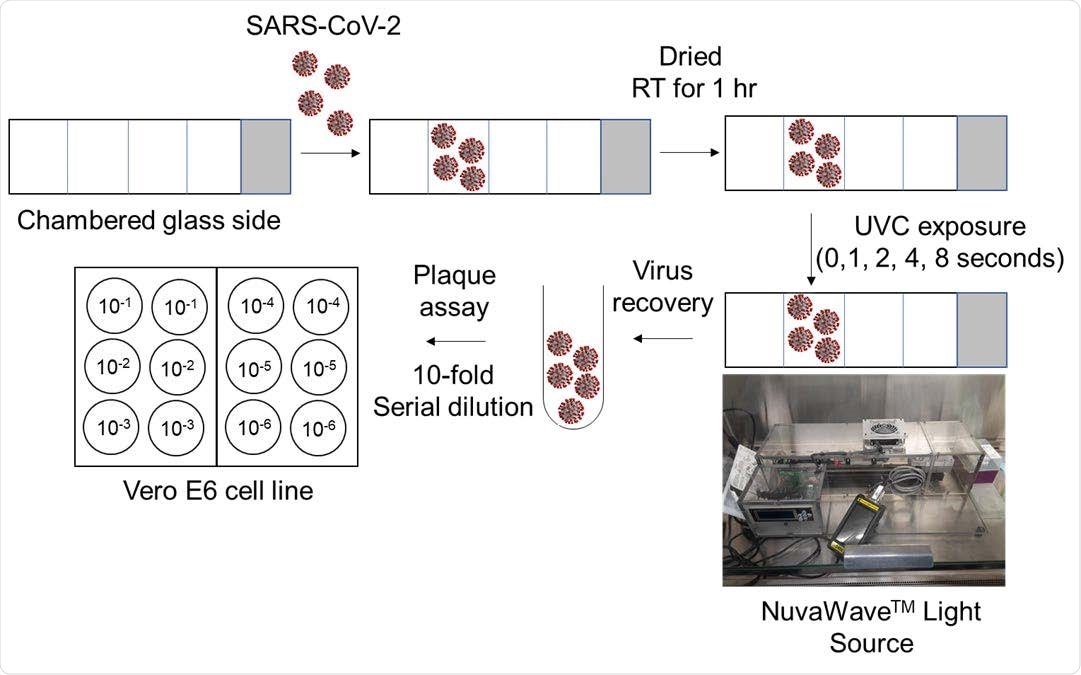A team of scientists from the Texas Biomedical Research Institute and UV Innovators, Inc., USA, recently developed an ultraviolet C radiation emitting device called NuvaWave, which is capable of inactivating severe acute respiratory syndrome coronavirus 2 (SARS-CoV-2) on glass surfaces within seconds. The study is currently available on the bioRxiv* preprint server.

Schematic representation of the workflow. SARS-CoV-2 was placed on the chambered glass slide, dried for 1 hour at room temperature, and then exposed to UVC light radiation using the NuvaWave device for 1, 2, 4 and 8 seconds. No UVC light exposure was used as control. After UVC light exposure, virus was recovered, serial diluted and used to assess viable virus in Vero E6 cells by the plaque assay.

 *Important notice: bioRxiv publishes preliminary scientific reports that are not peer-reviewed and, therefore, should not be regarded as conclusive, guide clinical practice/health-related behavior, or treated as established information.
*Important notice: bioRxiv publishes preliminary scientific reports that are not peer-reviewed and, therefore, should not be regarded as conclusive, guide clinical practice/health-related behavior, or treated as established information.
Background
SARS-CoV-2, the causative pathogen of coronavirus disease 2019 (COVID-19), is an enveloped RNA virus that primarily spread via respiratory droplets. However, strong evidence is now available to support the possibility of airborne transmission of SARS-CoV-2. In addition, a growing pool of evidence has suggested that surface contamination, especially in hospitals and public places, might also increase the risk of SARS-CoV-2 transmission. Thus, in addition to following pandemic-related control measures at person-level, such as wearing face masks, sanitizing hands, and maintaining physical distancing, it is important to reduce the risk of surface contamination through frequent sterilization.
Given the well-established effectiveness of ultraviolet C (UVC) radiation in eliminating pathogens from surfaces and air, the current study scientists have developed a device called NuvaWave that generates non-ionizing UVC radiation at a wavelength of 270 nm, which is sufficient for germicidal efficacy.
Study design
NuvaWave is a computer-controlled, powerful, handheld device, which is designed to disinfect surfaces with UVC radiation by moving the device over the surface from a distance of 1 to 3.5 inches. An external battery pack has been attached to the device to support up to 3 hours of use, and a computer monitoring system has been incorporated to ensure steady performance over time. The UVC radiation source of the device is instantly controlled by a simple trigger mechanism.
To examine the efficiency of this device, the scientists engineered a computer-controlled robotic test fixture with the same UVC radiation engine as NuvaWave. This robotic fixture was designed to hold a chambered glass slide containing SARS-CoV-2 samples. Specifically, the viral samples were placed on the glass slide and allowed to dry in the biosafety level 3 laboratory. Afterward, the slides were placed into the robotic test fixture and exposed to UVC radiation for 1, 2, 4, and 8 seconds. Immediately after the exposure, the viral samples were reconstituted, and viral titers were estimated by plaque assay.
A total of 32 UVC light-emitting diodes (LEDs) were used in the device. In each LED, the reflectors were designed to provide uniform distribution of radiation across an area of 4 inches X 4 inches and a depth of 1 – 3.5 inches. The radiation engine was placed 2 inches above the viral sample. Under the radiation source, the viral sample and a sensor were moved at a constant speed. The sensor was used to measure the radiation dosage. The entire setup was built with a polycarbonate surrounding to avoid any possible UV exposure.
Important observations
The exposure of SARS-CoV-2 to UVC radiation for 1 and 2 seconds caused a significant reduction in viral titer compared to the unexposed control virus. Specifically, UVC exposure for 1 and 2 seconds resulted in >2.9 log10 and >3.8 log10 reductions in viral titers, respectively. Furthermore, UVC exposures for 4 and 8 seconds caused >4.7 log10 reductions in viral titers, which was beyond the detection limit.
In general, the titers of UVC-exposed virus remained significantly lower than the titer of unexposed virus at all time points tested. Importantly, more than 99.99% reduction in viral titer was observed with the average UVC dosage of 0.05 J/cm2 250 obtained at 4 second exposure time.
Study significance
The study describes the development and validation of a UVC radiation emitting device, NuvaWave, which shows high effectiveness in inactivating SARS-CoV-2 on glass surfaces. The UVC radiation emitted from this device has been shown to dose-dependently inactivate the virus within seconds.

 *Important notice: bioRxiv publishes preliminary scientific reports that are not peer-reviewed and, therefore, should not be regarded as conclusive, guide clinical practice/health-related behavior, or treated as established information.
*Important notice: bioRxiv publishes preliminary scientific reports that are not peer-reviewed and, therefore, should not be regarded as conclusive, guide clinical practice/health-related behavior, or treated as established information.